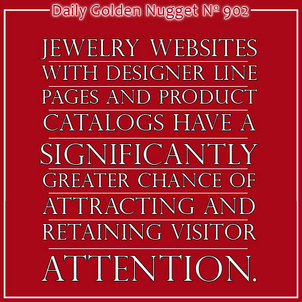 I'm digging deep into some numbers today to show you an easy way to increase the traffic to your jewelry website.
I'm digging deep into some numbers today to show you an easy way to increase the traffic to your jewelry website.For the past few years I've been continually tracking the increasing or decreasing effect on visitor traffic when two specific conditions are applied to a jewelry site. The first condition is whether or not there's a jewelry product catalog. The second condition is whether or not the website has designer line pages.
For my purposes, the jewelry catalog is actually built into the site, rather than something that appears in an iframe or is opened in a different browser window. The types of catalogs I'm interested in are the ones that you had to upload yourself rather than getting a simple link from your jewelry vendor.
For my purposes, a "designer line page" is a well-written web page that includes more than 200 words about a single designer. This page also has the designer logo and it could also have a few products. These types of pages are good search engine magnets for people who are specifically looking for that designer name. A typical jewelry store should have at least 5 designer line pages on their website for the more recognizable brands they carry.
During the 2013 holiday season, I was running a special test to see the specific effects of the catalogs and designer line pages would have on jewelry websites. For the test, I used 100 jewelry websites with different configurations to see which combination would have the best visitor results.
The first type of measurement I took was how the jewelry catalogs and designer lines compared as landing pages.
Jewelry catalog pages accounted for 7.35% of all landing page visitors.
Designer line pages accounted for 6.18% of all landing page visitors.
According to those simple numbers, you could say that the product catalog is better at attracting visitors to your jewelry site. In fact, I've found over and over again that large product catalogs do indeed create a significant visitor magnet to a jewelry site. Catalogs with thousands of products will attract thousands of visitors every month.
This next table shows us how the daily visitor measurements turned out based on the 4 possible configuration combinations.
| Configuration | Daily Visitors* | Avg Visit Duration | Bounce Rate |
| Designer Pages & Catalog | 100 | 00:10:15 | 37.44% |
| Catalog Only | 85.8 | 00:08:33 | 41.42% |
| Designer Pages Only | 75.3 | 00:09:42 | 35.03% |
| No Designer Pages or Catalog | 33.5 | 00:05:04 | 44.93% |
* The Daily Visitors shown is a normalized number on a scale of 1 to 100 to help you better understand the effect of each configuration
The configuration shown in the last row was the control group. Those websites were basic websites with simple store information and what services were offered.
What these numbers show us is that the retail jewelry websites that have both a jewelry catalog and information rich designer line pages will attract 66% more daily visitors than the control group. They have a 7.49% lower bounce rate than the control, and they keep the visitor's attention for more than double the amount of time than the control.
Websites with a catalog, but without designer pages, seemed to attract more people than websites that had designers but no catalogs. However, when you look carefully at the numbers, you will see that the designer line pages seemed to lead to lower bounce rates and longer visitor durations.
So what we have here are test results showing that the best configuration for your website should be to include well written designer line pages and a large product catalog.
Crafting the right type of designer line pages takes a little more writing and editing skill than simply uploading a product catalog. Ask your staff to write it if you don't feel qualified; otherwise you should be able to outsource it to a writer for hire on iwriter.com.
Uploading a large product catalog is no easy task either. It could take more than a month for a single person to upload just 1000 items.
Take a moment to contemplate the amount of time and effort it will take to create all the designer line pages, and to upload the products. As part of your contemplation, I also want to point out the results from the control group of websites shown above.
Now ask yourself if your business would increase at all if you had 66% more daily visitors to your website that spent more time looking around.
You have to assume that you'd be able to directly measure an increase in sales from the previous year simply from the effort you put into building the website with both designer line pages and a significant product catalog.








